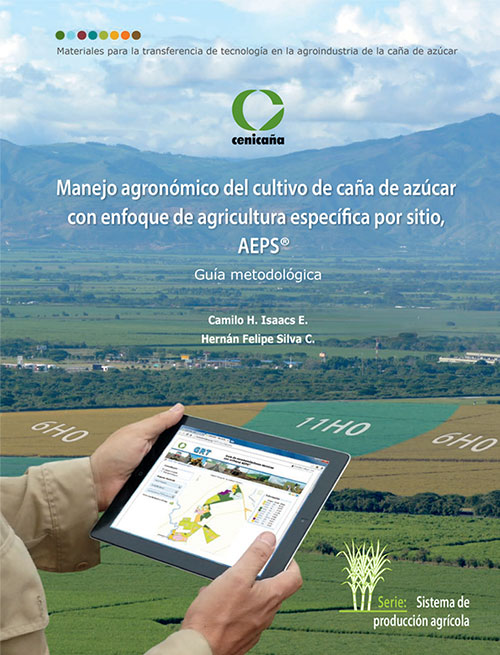Site-specific agriculture is an approach to the development of local production systems in which the decisions of the agricultural companies are based on the knowledge of the agro-ecological reality and the productive potential of the cultivation sites for, according to the company's goals, select the plant varieties and agronomic management practices that best adapt to each condition.
The sugarcane growers and sugar mills of the Cauca River Valley recognize the advantages of this approach, so that the adoption of site-specific agriculture (AEPS®) is a priority in the sector's strategic plans.
In this methodological guide we present the fundamental concepts of the AEPS and the information tools developed by Cenicaña to support sugar producers in their decisions on technological innovation and sustainable development based on the AEPS. To facilitate the achievement of learning objectives, the theoretical references are complemented with self-assessment activities, exercises and group practices.
The guide was developed to facilitate training events with end users of agricultural production technology, and is aimed at professionals in technical assistance, farm administration and agronomic research of sugar cane mills and organizations in the valley. from the Cauca River, as well as technology transfer professionals from Cenicaña. This group of professionals are identified in the guide as facilitators of training and learning, technological adoption and knowledge management.
Thus, with the help of the technology adoption facilitators, it is expected that the participants in the training will know the concept of agroecological zoning, understand it and know how to apply it in the agronomic management of the crop. In addition, that they are able to efficiently use the AEPS tools available on the Cenicaña website, in order to obtain reliable information for technical decision-making in their companies.
AEPS decisions are based on the characterization of the cultivation sites. This is why in the first learning unit we explain the methodological principles of agroecological zoning (fourth approach) (Carbonell et al., 2011), with emphasis on the criteria for the recognition of soils in detailed studies (Igac, 2006) and its classification into homogeneous groups (Quintero et al., 2008) and the verification of humidity groups.
Having reliable information in the agronomic management decisions of the productive units requires different databases and analysis tools that are safe and easy to use.use. In the second learning unit the AEPS information system is described® and the tools available to registered sugar producers on the website of Cenicaña, with emphasis on the geographic information system (GIS) map server.
Finally, the third and last unit is dedicated to the technical recommendations guide (GRT) (Isaacs and Silva, 2012), a tool that is part of the AEPS information system on the web, which integrates knowledge validated in a participatory way by Cenicaña, sugar mills and sugarcane growers in the Cauca river valley about the site-specific farming practices best suited to the development of the crop in a type of cane (Isaacs et al., 2011).

Material produced within the framework of the Apprenticeship and Technical Assistance Program, PAT.
Bibliographic citation:
Isaacs Echeverri, CH and Silva Cerón, HF 2014. Agronomic management of sugarcane cultivation with a focus on site-specific agriculture, AEPS®. Methodological guide. Ashtray. Cali, Colombia. 156 p. (Materials for technology transfer in the sugarcane agribusiness. Agricultural production system).
You can also check:
PAT - Apprenticeship and Technical Assistance Program
Methodological guides and teaching materials.












